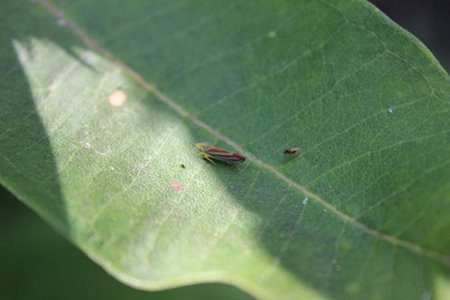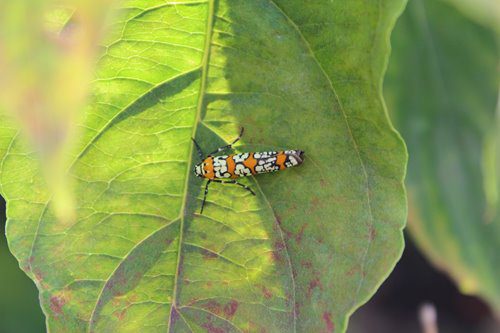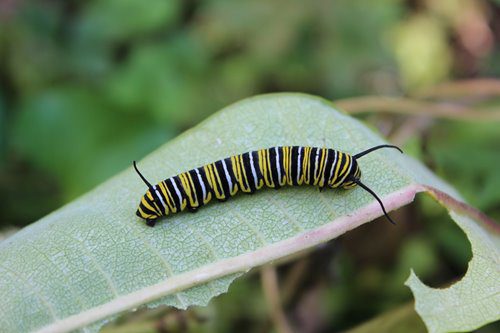Dave and I performed our usual weekly check on the pond in OHCs Bird Sanctuary a few days before the equinox and found a few interesting insects still hanging around and making the most of the last warm days of summer. Here’s a sampling of the highlights!
[image removed]
These Large Milkweed Bugs (Oncopeltus fasciatus) suck the juices out of milkweed plants with their piercing mouth parts. Both full-grown adults and younger nymph instars are pictured here. They are migratory in the northern reaches of their range, so these critters have likely headed south for warmer weather by now.
 The tiny Candy-striped Leafhopper (Graphocephala coccinea) is easy to overlook, but is surprisingly common and occurs in a wide variety of habitats. Even this late in the season you might still be able to find one in your own back yard! When disturbed they rocket away on their powerful hind legs, hence the name leafhopper.
The tiny Candy-striped Leafhopper (Graphocephala coccinea) is easy to overlook, but is surprisingly common and occurs in a wide variety of habitats. Even this late in the season you might still be able to find one in your own back yard! When disturbed they rocket away on their powerful hind legs, hence the name leafhopper.
 Small but stunning Ailanthus Webworm Moths (Atteva aurea) can be found resting on vegetation during the day, like this one, but they are also drawn to porch lights at night. The drab grey larvae feed on the non-native ornamental Tree of Heaven.
Small but stunning Ailanthus Webworm Moths (Atteva aurea) can be found resting on vegetation during the day, like this one, but they are also drawn to porch lights at night. The drab grey larvae feed on the non-native ornamental Tree of Heaven.
 I stumbled upon this Red-headed Bush Cricket (Phyllopalpus pulchellus) while pulling out some excess Common Bindweed from our milkweed patch. She was waving those paddle-shaped pedipalps like little boxing gloves as she explored the leaf surface. The male of this species produces a stuttering, high-pitched trill that is surprisingly loud for its size (1.5cm).
I stumbled upon this Red-headed Bush Cricket (Phyllopalpus pulchellus) while pulling out some excess Common Bindweed from our milkweed patch. She was waving those paddle-shaped pedipalps like little boxing gloves as she explored the leaf surface. The male of this species produces a stuttering, high-pitched trill that is surprisingly loud for its size (1.5cm).
 I believe this smallish wasp is a Blue Mud Dauber (Chalybion californicum). She seemed particularly interested in the rocks around the pond where wed splashed them with the hose. She was very fast-moving (and difficult to photograph!) but totally uninterested in us. Blue Mud Daubers are solitary, and modify the abandoned nests of other wasps rather than constructing their own. Their preferred prey are spiders, particularly cobweb weavers like the Black Widow!
I believe this smallish wasp is a Blue Mud Dauber (Chalybion californicum). She seemed particularly interested in the rocks around the pond where wed splashed them with the hose. She was very fast-moving (and difficult to photograph!) but totally uninterested in us. Blue Mud Daubers are solitary, and modify the abandoned nests of other wasps rather than constructing their own. Their preferred prey are spiders, particularly cobweb weavers like the Black Widow!
 A very welcome surprise in our milkweed patch, this Monarch caterpillar is close to pupating. This was the only larva I was able to find. I hope he/she was able to pupate before the weather turned a couple days later! The next time you’re at the Ohio History Center, stop by our Bird Sanctuary’s viewing area in the Archaeology exhibit. Although fall is upon us, many other wildlife species will continue to frequent the pond for several weeks to come. You never know what you might see landing on our bird feeders!
A very welcome surprise in our milkweed patch, this Monarch caterpillar is close to pupating. This was the only larva I was able to find. I hope he/she was able to pupate before the weather turned a couple days later! The next time you’re at the Ohio History Center, stop by our Bird Sanctuary’s viewing area in the Archaeology exhibit. Although fall is upon us, many other wildlife species will continue to frequent the pond for several weeks to come. You never know what you might see landing on our bird feeders!